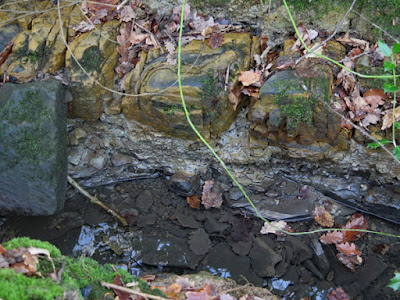 |
| Spheroidal weathering in Bowden Housteads Wood |
After seeing the Carr Brook disappear into the culvert in the south-west part of Bowden Housteads Wood, I crossed over the A57 and, passing Parkway Man, I followed the path over the footbridge on the Sheffield Parkway.
During my previous walk to look at the geology in the northern sector of Bowden Housteads Wood, I had followed a tributary of the Carr Brook but, on this occasion, I took the path that runs clockwise around Parkway Fire Station.
Finding a steep sided valley where I couldn’t get down to the stream bank, I followed the path along the course of the Carr Brook without seeing any rock outcrops. Arriving at the confluence with this upper tributary, I then went in search of another lower tributary, where I had found a dry streambed with the bedding plane of a flaggy sandstone exposed.
I didn’t find this particular exposure but, with the thick undergrowth having died back, I was able to get close to the bank of the stream and followed its course for a few hundred metres - across various Pennine Middle Coal Measures Formation (PMCMF) rocks - until it disappeared into a culvert beneath the Sheffield Parkway.
As with my walk along Shirtcliff Brook a couple of weeks earlier, I encountered stream bank sections of black topsoil overlying mudstone, which is weathered to yellow clay, and various unweathered mudstones and siltstones.
A little further upstream, in places the stream channel is not well defined and widens out into muddy pools, where accumulations of dead leaves are mixed up with layers of silt that have spread out over them in times of flood.
Although I wasn’t able to establish their precise position in the landscape without GPS, the geological map of the area shows that I crossed two minor PMCMF sandstone bodies, which were formed in swamps, estuaries and deltas.
In several places, the bedding planes of flaggy sandstone/siltstone are exposed in the streambed, with individual beds occasionally up to 150 mm thick, but generally these do not develop into massive sandstone and frequently pass into fine siltstone and mudstone.
During this walk and other investigations of streams on the PMCMF strata in South Yorkshire, I had encountered numerous examples of yellow clay in the stream banks and, having resumed following the stream in Bowden Housteads Wood, after it had passed beneath a path in a culvert, another yellow coloured rock caught my eye.
Exposed over a length of just a few metres, the typical siltstone/mudstone in the stream bank passes upwards into a more massive sandstone that exhibits spheroidal weathering, with the dark body of the sandstone changing to a marked yellow colour.
I had never seen anything like this before and I wished that I had a geological hammer and a pair of wellingtons with me, so that I could get down into the stream bank and further investigate – especially since, in places, this bed appears to pass laterally and vertically into yellow/grey clay.











No comments:
Post a Comment